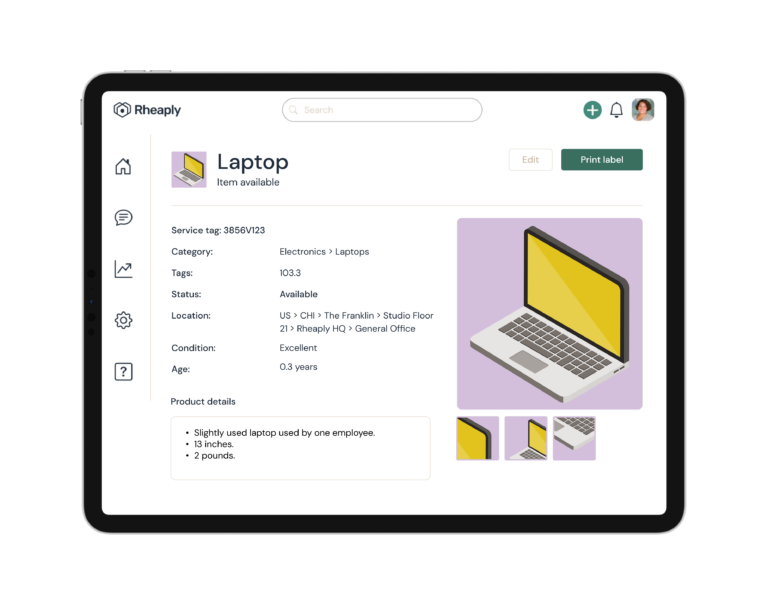Equipment Inventory Management Software
Rheaply puts reuse on the table for every organization.
Equipment Inventory Management Software
Effective inventory management is crucial for businesses transitioning to a circular economy model, which promotes the reuse and recycling of resources to minimize waste. An important aspect of this transformation is the adoption of equipment inventory management software. With these tools, organizations can manage their assets systematically.
Because the circular economy philosophy lies in the notion that resources should be optimized for continual use, each piece of inventory is seen as an asset that can be used to create an eco-friendly value loop. Asset inventory management software is well-suited for this type of model. Documenting the lifecycle of each asset, it enables users to monitor and manage resources more efficiently, thereby facilitating the adoption of the circular economy.
Imbalanced inventory levels can lead to major disruptions and significant business losses. As such, many companies go to great lengths to ensure they have the right amount of inventory. Inventory management tools allow businesses to avoid overstocking and understocking equipment by providing real-time inventory levels. This minimizes waste and promotes more efficient usage.
These are just some of the reasons that more and more businesses are implementing inventory management tools. These solutions streamline the processes streamline inventory management, and equip businesses with the tools and data they need to make strategic decisions regarding their resources.
Here’s a closer look at the key benefits of using an inventory management system:
- Waste Minimization: Efficient inventory management software helps users understand exactly what items they have, how often those items are used, and when they need to be replaced. This reduces waste.
- Cost Efficiency: Leveraging accurate inventory data, businesses can avoid the financial losses associated with overstocking and understocking. Predictive analytics in modern software can also help anticipate demand and optimize procurement processes.
- Maximization of Resource Value: By tracking the lifecycle of each asset, organizations can ensure the maximization of the value of each item by extending its lifecycle or recycling it.
- Regulatory Compliance: Another great thing about inventory management software is that it tracks the disposal of inventory items. This allows users to remain compliant with environmental regulations, avoiding fines and contributing to their corporate social responsibility goals.
- Improved Business Sustainability: Businesses that adopt circular economy principles can enhance their brand image as environmentally-conscious entities, attracting customers and partners who share similar values.
- Efficient Operations: Real-time tracking helps in quickly locating equipment when needed. This cuts downtime and improves productivity.
In today’s increasingly competitive business landscape, it has become increasingly crucial for businesses to differentiate their brands from others. One of the best ways they can do so is by using inventory management solutions. Such tools make it easier for companies to track inventory levels and make adjustments as needed to ensure they have just the right amount of stock at all times.
A resource exchange can likewise be a valuable solution for companies that experience frequent changes in their equipment requirements. Exchange programs are often supported through asset inventory management software, making it easy for buyers and sellers to connect. For example, if a company needs to downsize, they can sell surplus furniture items to other businesses that require them, thereby reducing waste and generating revenue.
Equipment Inventory Software
Inventory management tools and techniques are increasingly being used to support circular economy practices and resource optimization, integrating all processes from procurement to end-of-life handling. These tools allow companies to optimize their resources by maintaining control over inventory levels. For example, predictive analytics tools can forecast demand, making it easier for users to purchase the appropriate amount of stock.
Resource lifecycle management is another important technique involved in tool inventory management. This approach aligns with circular economy principles because it aims to prolong the lifespan of resourcing. By tracking the use of equipment, these tools can help identify opportunities to keep items in circulation for a longer period of time.
Tool inventory management is another essential technique for effective inventory management. It involves cataloging each tool involved in the process, recording its specifications, usage history, and responsible personnel. This aids in preventing loss or theft, which can ultimately boost productivity and minimize downtime due to missing equipment.
The type of management also includes a check-in/check-out system, which records the details of when and to whom tools are issued. This encourages accountability, making it easier to identify and correct misuse or negligence. A tool tracking system like this can be particularly useful for businesses with multiple employees that are constantly checking out tools. Trying to manage the location of tools by hand can be difficult, and it’s far too easy to lose track of which items are where. An automated tracking system helps solve this issue.
Finally, it’s important to enact a proactive maintenance schedule to manage inventory effectively. Regular maintenance extends the useful life of tools and equipment, thus supporting the circular economy model by maximizing resource utilization and minimizing waste. Maintenance schedule features allow for the scheduling of regular inspections and preventive maintenance tasks, keeping tools in optimal condition. It will also alert responsible individuals about upcoming maintenance activities to ensure they are carried out on time.
The significance of equipment inventory management software in today’s business landscape is underscored by its capacity to streamline operations and promote sustainable practices. It provides accurate, real-time tracking and proactive maintenance scheduling, reducing waste and cutting costs. Looking ahead, this software is likely to shape the future of business by driving the circular economy.
As more and more companies embrace and adopt sustainability as a core brand tenet, these tools are likely to play an increasingly pivotal role in aiding the transformation from manual, environmentally-harmful practices to processes that support a greener future. While this transition poses its fair share of challenges, specialized tools and software can be leveraged to make the switch easier for everyone involved.
Equipment Inventory Software
With the growing number of equipment inventory software solutions available on the market today, it can be difficult to find the one that’s right for your organization. Whether you’re a small business or a large enterprise, selecting the most appropriate tool for your specific needs can improve your ability to adopt circular economy principles and promote reuse. The following are some tips to consider when selecting an inventory management tool:
- Identify Your Needs: Before starting your search, take the time to identify your business requirements. For instance, if you run a small company, you may benefit most from inventory management software for small businesses. Conversely, if you work with a large enterprise, then you should look specifically for enterprise inventory management software.
- Consider Software Compatibility: Make sure the software is compatible with your current systems. If you use specific ERP or CRM systems, the inventory management software should integrate seamlessly with those.
- Prioritize a User-Friendly Interface: Opt for a solution with an intuitive, user-friendly interface. This will decrease the learning curve for employees and ensure swift adaptation to the new system.
- Scalability: Choose a system that can grow with your business. The software should be able to accommodate increased data volume and additional functionalities as your business needs evolve over time.
- Vendor Reputation: Consider the reputation of the software vendor. Look for reviews and testimonials from other users, and evaluate their customer service and technical support.
- Security Features: The software should provide robust security features to protect your sensitive data.
Next, ensure a smooth transition from the old to the new:
- Train Your Staff: Once you’ve selected your software, thoroughly train staff on its features and functionalities. This will maximize usage and efficiency.
- Migrate Data Carefully: Make sure that all existing inventory data is carefully transferred to the new system, as any inaccuracies can cause significant issues down the line.
- Perform Regular Updates: Keep your software updated to enjoy the benefits of new features and enhanced security.
- Continually Review Performance: Regularly review the system’s performance to identify any areas of improvement.
After implementation, it’s important to monitor the impact of the equipment inventory app on your circular economy and reuse efforts.
How to gauge success of your inventory management software:
- Waste Reduction Metrics: Monitor changes in waste production before and after implementing the software. Reduced waste indicates efficient resource management.
- Asset Lifespan: Keep track of the lifespan of your assets. If you see an increase in the average lifespan, it indicates effective maintenance and reuse facilitated by the software.
- Inventory Turnover Rate: A higher inventory turnover rate indicates efficient inventory management and may suggest better alignment with circular economy principles.
- Compliance Reports: Use the software’s data to keep your business compliant with environmental regulations. Improved compliance rates demonstrate progress towards a circular economy.
- Cost Savings: Reduced procurement costs and improved cost efficiency are positive indicators of the impact of the inventory management system.
- Customer Satisfaction and Retention: Measure changes in customer satisfaction and retention. If customers appreciate your efforts towards sustainability, you may see an increase in retention rates.
It’s not enough to simply put a new system in place—to truly reap the benefits of an inventory management system, businesses should look at quantitative metrics to determine the impact of the software on their operations. That way, they can determine whether or not the software is yielding the expected ROI.



